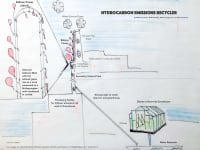Problem:
CO2 emissions are a problem that cannot be ignored. Despite worldwide attempts at legislation and organization, experts predict that emissions will continue to climb 2% per year going forward. Coal and other hydrocarbon plants that generate power are some of the largest contributors of atmospheric CO2. State-sponsored resolutions to decrease CO2 emissions have proved costly. Business entities and municipalities are motivated to find novel, cost-effective solutions to both decrease current atmospheric CO2 and the current production of CO2 exhaust.
Solution:
With minor retrofitting to current hydrocarbon combustion plants, our Flue-Exhaust Recycle System will convert waste pollution into useful products and create enough additional electricity to power this process.
Installation of an outflow pipe at the base of the plant exhaust stack will redirect hot hydrocarbon exhaust for additional processing and generation of electricity. Stirling generators installed at the base of the stack are attached to small balloons inflated using the exhaust gasses. These balloons rise on a track installed on the stack, generating electricity via their attachment to the Stirling generators. The power generated is used to process the captured outflow gases from the exhaust stack.
Captured hydrocarbon exhaust processed using several extant methods into additives to bolster plant growth at an onsite greenhouse fertilizes non-food plants (bamboo, hemp, cotton, algae, or hardwood) for use in textiles or structural materials. Our preliminary testing shows that doping closed greenhouses with CO2 and H2O accelerates plant growth. Portions of these grown plants can be manufactured into additional balloons and structural elements for greater greenhouse space. Leftover hydrocarbon emissions will be converted into other useful materials (e.g., carbon nanotubes, dry ice, compressed CO2 gas).
Benefits:
Alternative energy: This process proposes a novel way of reducing net emissions and repurposing these previously waste emissions while generating additional electricity.
Saves money and bolsters the economy: Some businesses are forced to pay taxes for emissions. Businesses that will utilize our service will reduce their emissions tax burden.
Reduces waste and consumption of natural resources: Products made from the reclaimed waste gases can be made into new products (e.g., textiles, carbon nanotubes, plastics, paper, fuel, etc.)
Why This Solution?
Novelty: This solution utilizes balloons, a centuries-old technology, but applies them in a new useful, environmentally helpful way.
Versatility: This solution is applicable to any combustion-based fuel source that generates heat and utilizes a chimney or flue. Similar technologies can be installed at different scales in residential and rural areas across the world. Ours is a very flexible technology. Once carbon exhaust is reclaimed, it can be manufactured into many applications. Additionally, having the ability to manage atmospheric gases has aerospace applications.
Future Work
-Develop application for oven/cookfire exhaust (National Geographic: almost 3 billion people primarily cook food over open flames.)
-Partner with reverse-combustion and other companies to process captured exhaust
-Partner with local combustion plant for testing
-100% exhaust capture using sealed balloons
-Improve safety factor of design for interactions between balloons and ambient wind.
Like this entry?
-
About the Entrant
- Name:Kyle Summers
- Type of entry:teamTeam members:Nick Brackley
Allison Sheppard
Kyle Summers - Patent status:none





